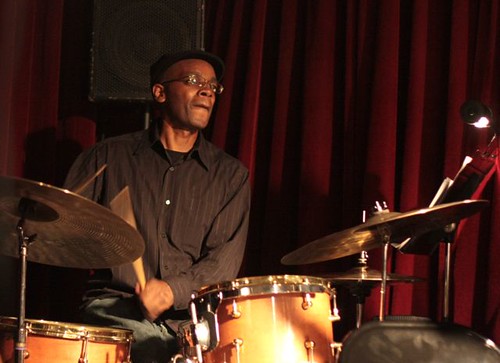
Kim Kirkpatrick: I have been interested in dub ever since purchasing the Mikey Dread LP recently reviewed below. A couple of excellent Creation Rebel albums soon followed, as well as Lee Scratch Perry productions. But I really became a fanatic in 1980 when Adrian Sherwood started his On-U Sound label. His amazing, jaw dropping production and the core group of heavy dub musicians he recorded became a significant part of my musical listening. The On-U Sound catalog proved to be some of the most treasured dub music I would ever own. I used several such recordings on the current dub mix, for example, Bim Sherman, New Age Steppers, Mark Stewart and Mafia, and African Head Charge.
Dub music's origins go back to the late sixties, with sound systems and DJ's performing at outdoor dance parties. Producers in the studios created instrumental versions of vocal reggae tracks, and these dub versions (the B sides) were used to lengthen the playing time of a song. A DJ could move back and forth from the vocal to dub versions, extending the mix and thus the dance floor mood indefinitely. Dub was quickly adopted as a backdrop for toasters, DJs who talked or rapped over the instrumental melodies and rhythms. Dub was also an opportunity for the producers to show off their own skills and musicianship (using very crude equipment), breaking down the source material, exploring and altering the music with their own, distinctive styles.
The echo effects, cavernous reverb, sound effects, sampling, heavy bass, and the mixing board itself defined the sounds of studios and their creative producers. The popularity and progress of dub was swift, and the musical form moved beyond merely dropping vocals out or just extending a song for the purpose of DJs and rappers.The best of these producers stretched dub into new territory, new sonic effects and beats, and longer, more expansive tracks with more complexity.The prime period of dub was from it's origins in the late sixties (Lee Scratch Perry, Herman Chin Loy for example) up until the mid to late eighties (Scientist, Mad Professor, Bill Laswell, Alpha & Omega are examples). At some point in the eighties synthesizers took over, the beats got more regimented, the bass more mechanical, and the natural feeling in the music was gone. A generalization for sure, excellent dub was produced through the eighties, but its peak and pure form was over by that decade. Conversely, by the eighties dub was having a big effect on other music around it, and to this day its influence and atmosphere can be heard in a variety of musical forms.
What is it about dub that attracts me, has led to my having a large selection of CDs spanning four decades? Dub is thick with atmosphere, texture, and a wide tonal range from deep bass to high rim shots. Secondly, it has origins in song structures but moved away from the progression of a song with clear beginnings, choruses or endings. Dub music is about using a stripped down song or selected tracks and expanding off of that platform, and the further out the producer takes it the more I enjoy it. Third, I am attracted to the authenticity of dub, the all consuming and lifelong commitment of it's musicians and producers. Finally, I have always been a big fan of bass, be it Jack Cassady, Danny Thompson, Jah Wobble, Sara Lee, or Charlie Haden, to name a few.
I still prefer dubs formative roots, and fortunately there is no need to get nostalgic or despair if you are so inclined. An abundance of labels exist for you to explore the early, prime period of dub. Some of my favorites are: Blood and Fire, Pressure Sounds, Tamoki Wambesi, Jet Star, Jamaican Recordings, Wackies, and Basic Replay (which reissued Keith Hudson's Flesh Of My Skin Blood of My Blood which was reviewed in January). Another good move would be to find a friend or two who can guide you through dub, or at least share in the good and bad purchases inevitable in pursuit of dub music. I am exceedingly fortunate to have a long time friend who has shared his infinite knowledge of reggae and dub, and given me many an essential and rare recording . I met BC through a particularly competitive eBay purchase. As I recall he felt bad about how much I was paying him for the CD and offered a short list of reggae he could send along as CDRs for my added enjoyment. Well, the first list I politely said "Thank you but no thank you, I already have all of them". I gave the same reply for a second list from BC. After that our conversations and sharing of music took off and we became very good friends. I have never met BC but we have continued to share music for many years as well as our fear and fascination with clowns. The biggest of props for BC, for sharing his knowledge of reggae and rap, and for being a generous friend. I am still working on his rock education, as much as he can bear. The last I heard Jimi Hendrix's first three albums had grabbed his attention and BC was nowhere near to moving on.
Bob Burnett: In addition to the NO KILL FI DUNZA write up, Kim has put together a mix of choice dub. All ya gotta do is click the black kitty and away you go!













